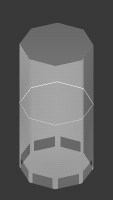An example of flow simulation inside a two-stroke engine with opposed pistons, using our grid-free CFD code. Note that only the bounding surfaces of the engine need gridding; the complex and often tedious volumetric meshing process that traditional CFD methods have to contend with is eliminated altogether. This leads to substantial disk space and memory savings, as well as significant reduction in problem setup time.

In this engine
configuration, fresh charge enters the chamber from the eight inlet
ports at the top, while combustion residuals are expected to exit the
chamber from the eight exhaust ports at the bottom. The objective of
the simulation is to study turbulent mixing for this particular design,
the characterization of which will hopefully lead to the design of an
engine with more efficient combustion properties.
Note that the particles that eject from the inlet ports into the swirling motion of the chamber are the actual computational grid points - the vortex elements. See the example of impulsively started flow over a cube for a brief description. The elements are color-coded by port number to facilitate the visual inspection of the mixing effectiveness of this particular engine design. The well-mixedness of the swirling flow by the end of the compression process is fairly clear by the near-uniform distribution of the particle colors across the engine.
More on this engine simulation in [15].